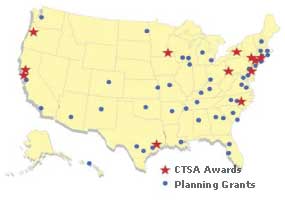Contents
- Cover Story
Forging a Path From Laboratory to Clinic
Critical Resources
Forging a Path From Laboratory to Clinic
Training the Next Generation of Translational Scientists
In addition to supporting Marks’ research, Oregon Health & Science University’s CTSA has provided training opportunities for a graduate student and medical student in his lab to become “card-carrying translational researchers,” says Marks. The CTSA offers several courses through its Human Investigations Program to train health care professionals who want to make clinical research a substantial part of their long-term career goals.

Twelve institutions participate in the CTSA consortium. An additional 52 institutions have received planning grants to help them prepare applications to join the consortium.
Through this program, students can attend such courses as “Introduction to Clinical Research,” “Clinical Research Design,” and “Biostatistics and Protection of Human Subjects” as part of certificate, master’s, and non-degree tracks. These courses provide training in clinical research from the initial trial design to data analysis and presentation, equipping students with the necessary expertise to pursue an independent career in this field.
Such training programs were established at Oregon and other CTSA institutions due to a realization that the scope of knowledge and expertise needed to be an effective translational or clinical scientist can no longer be acquired on the job as was done in the past (see “CTSAs IN FOCUS”). “We now offer different programs suited to different needs,” says Berglund.
The three studies at Rockefeller, Oregon, and Penn span the continuum of clinical and translational research—from studies in the laboratory that may lead to new drugs, to animal models of disease that give important insights into human conditions, to new therapies tested in patients. They are just a few examples of the countless advances to be facilitated through the programs and resources established through the CTSA consortium.
As this initiative continues to expand with different CTSAs collaborating and sharing resources, it will help speed the course of translational and clinical research, ultimately benefiting the nation’s health. “When we first got funded, I just wanted to focus on getting our own programs off the ground,” says Berglund. “But the consortium has since become the most important part of our efforts. We are coming together at every level and really starting to work as a unit.”



